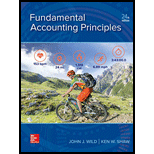
Concept explainers
Concept Introduction:
Predetermined overhead rate- Predetermined overhead rate is the rate on which company allocates the indirect costs to manufacturing overhead account.
Predetermined overhead allocation rate is calculated as follows-
Under or Over applied overhead-
Under or Over applied overhead- It is the difference between the actual and applied overhead.
If the actual overhead incurred is more than the overhead applied during a particular period, then it is a case of under-applied of overhead cost.
If the actual overhead incurred is less than the overhead applied during a particular period, then it is a case of over-applied of overhead cost
- Predetermined overhead rate
- Total overhead cost applied to each job
- Over or under applied overhead
Answer to Problem 4APSA
(a) Predetermined overhead rate
(b) Total overhead cost applied to each job
| Job No. | Direct Labor | Applied overhead (60%) |
| 201 | 604,000 | 362,400 |
| 202 | 563,000 | 337,800 |
| 203 | 298,000 | 178,800 |
| 204 | 716,000 | 429,600 |
| 205 | 314,000 | 188,400 |
| 206 | 17,000 | 10,200 |
| Total | 2,512,000 | 1,507,200 |
(c) Over or under applied overhead
| Particulars | Amount ($) |
| Actual overhead cost | 15,20,000 |
| Less: Applied overhead cost | 15,07,200 |
| Under applied overhead | 12,800 |
Explanation of Solution
(a) Predetermined overhead rate
Given, Estimated overhead cost = $1,500,000
(b) Total overhead cost applied to each job
Given,
Direct labor cost-
(c) Over or under applied overhead
Given,
Conclusion:
Thus, the predetermined overhead, applied overhead and under applied overheads are determined.
Concept Introduction:
Cost of goods sold -
Cost of goods sold can be defined as the total cost assigned to the goods that are sold during a period of time. It is calculated by summing up all the costs incurred starting from purchases till the process of manufacturing.
Adjusting entries are prepared to complete the financial statement of the company and to reflect the accrual method of accounting. Adjusting entries are prepared before issuance of financial statement.
To prepare the adjusting entry.
Answer to Problem 4APSA
Adjusting
| Date | Accounts titles and Explanation | Debit ($) | Credit ($) |
| Dec.31 | Cost of goods sold | 12,800 | |
| Factory overhead | 12,800 | ||
| (To assign under-applied overhead) |
Explanation of Solution
Explanation for journal entry-
When overhead is under applied, the jobs are charged with less overhead than the actual and cost of goods sold will be charged with less overhead. Cost of goods is a cost and its balance increases, so it is debited and factory overhead is credited.
Conclusion:
Thus, overhead is under applied by $12,800.
Want to see more full solutions like this?
Chapter 19 Solutions
Fundamental Accounting Principles
- I need help finding the accurate solution to this general accounting problem with valid methods.arrow_forwardCan you help me solve this general accounting problem using the correct accounting process?arrow_forwardCan you solve this financial accounting problem using accurate calculation methods?arrow_forward
- Gabrien is a full-time exempt employee at a local electricity co-operative. He earns an annual salary of $55,130 and is paid biweekly. He contributes 3% of his earnings to his 401(k) account and has no other pre-tax deductions. What is his Social Security tax deduction for each pay period?arrow_forwardPlease explain the solution to this financial accounting problem with accurate principles.arrow_forwardPlease provide the answer to this general accounting question using the right approach.arrow_forward
- Please provide the correct answer to this general accounting problem using valid calculations.arrow_forwardCan you explain the correct methodology to solve this general accounting problem?arrow_forwardPlease provide the solution to this general accounting question with accurate financial calculations.arrow_forward
- I need help with this general accounting question using standard accounting techniques.arrow_forwardThe Great Eastern TableGreat Eastern Table Company produces dining tables in a three-stage process: Sawing, Assembly, and Staining. Costs incurred in the Sawing Department during September are summarized as follows: Working in process inventory sawing. September 1 balance = 0Direct materials = 1,860,000Direct labor = 143,000Manufacturing overhead = 161,500Direct materials (lumber) are added at the beginning of the sawing process, while conversion costs are incurred evenly throughout the process. September activity in the Sawing Department included sawing of 13,000 meters of lumber, which were transferred to the Assembly Department. Also, work began on 2,000 meters of lumber, which on September 30 were 75% of the way through the sawing process.arrow_forwardBlack Oil Company is trying to decide whether to lease or buy a new computer-assisted drilling system for its extraction business. Management has already determined that acquisition of the system has a positive NPV. The system costs $9.4 million and qualifies for a 25% CCA rate. The equipment will have a $975,000 salvage value in five years. Black Oil’s tax rate is 36%, and the firm can borrow at 9%. Cape Town Company has offered to lease the drilling equipment to Black Oil for payments of $2.15 million per year. Cape Town’s policy is to require its lessees to make payments at the start of the year. Suppose it is estimated that the equipment will have no savage value at the end of the lease. What is the maximum lease payment acceptable to Black Oil now?arrow_forward

 AccountingAccountingISBN:9781337272094Author:WARREN, Carl S., Reeve, James M., Duchac, Jonathan E.Publisher:Cengage Learning,
AccountingAccountingISBN:9781337272094Author:WARREN, Carl S., Reeve, James M., Duchac, Jonathan E.Publisher:Cengage Learning, Accounting Information SystemsAccountingISBN:9781337619202Author:Hall, James A.Publisher:Cengage Learning,
Accounting Information SystemsAccountingISBN:9781337619202Author:Hall, James A.Publisher:Cengage Learning, Horngren's Cost Accounting: A Managerial Emphasis...AccountingISBN:9780134475585Author:Srikant M. Datar, Madhav V. RajanPublisher:PEARSON
Horngren's Cost Accounting: A Managerial Emphasis...AccountingISBN:9780134475585Author:Srikant M. Datar, Madhav V. RajanPublisher:PEARSON Intermediate AccountingAccountingISBN:9781259722660Author:J. David Spiceland, Mark W. Nelson, Wayne M ThomasPublisher:McGraw-Hill Education
Intermediate AccountingAccountingISBN:9781259722660Author:J. David Spiceland, Mark W. Nelson, Wayne M ThomasPublisher:McGraw-Hill Education Financial and Managerial AccountingAccountingISBN:9781259726705Author:John J Wild, Ken W. Shaw, Barbara Chiappetta Fundamental Accounting PrinciplesPublisher:McGraw-Hill Education
Financial and Managerial AccountingAccountingISBN:9781259726705Author:John J Wild, Ken W. Shaw, Barbara Chiappetta Fundamental Accounting PrinciplesPublisher:McGraw-Hill Education





